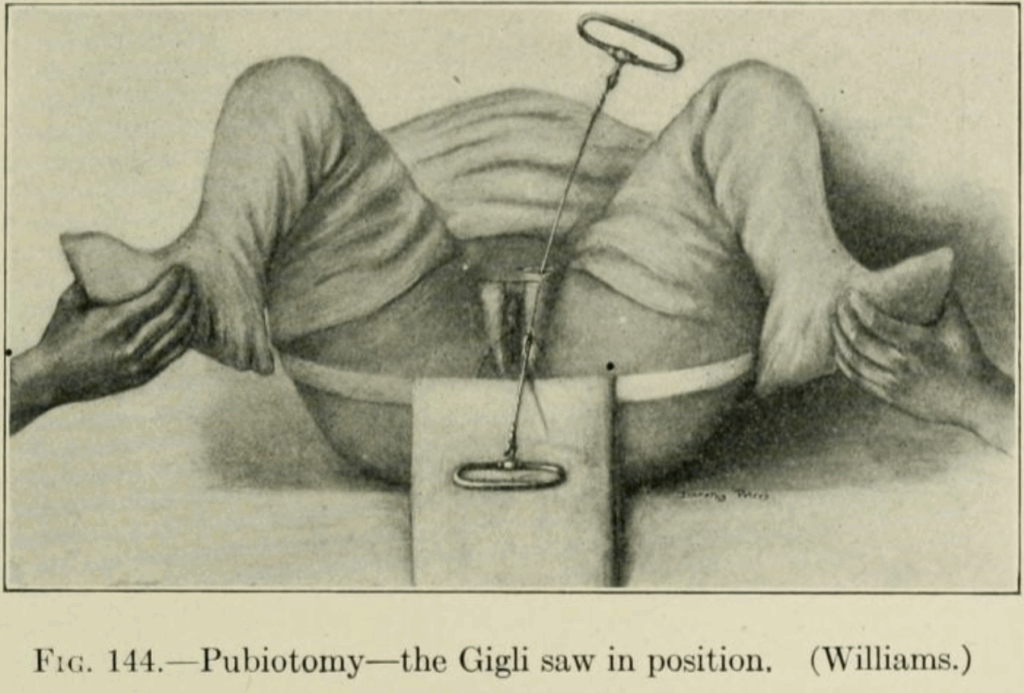Leonardo Gigli
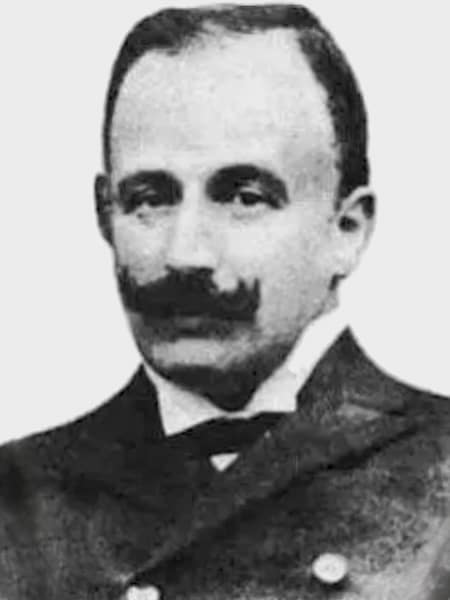
Leonardo Gigli (1863-1908) was an Italian surgeon and gynaecologist
Gigli recognised the risks of symphysiotomy and envisioned the “lateralized pubiotomy,” a surgical procedure named after him (Gigli’s operation)
He is eponymously remembered for the Gigli saw, used for his pubiotomy operation. Although now obsolete in the field of gynaecology, the bone saw is used in neurosurgery, thoracic surgery and orthopaedics…or to escape from prison…
Biography
- Born on April 30, 1863 in Sesto Fiorentino, Italy
- 1889 – MD, Firenze, nell’Istituto di studi superiori pratici e di perfezionamento
- 1890 – initiated into obstetrics by Professor D. Chiari.
- 1891 – attended the clinics of Tarnier, Budin, and Pinard in Paris and became interested in the problem of operative deliveries in cases of maternal pelvic deformities
- 1892 – moved to Breslau, Germany (now Wroclaw, Poland) and under the tutelage of Heinrich Fritsch (1844-1915) and conceived the Gigli wire saw for use in lateralised pubiotomy
- 1894 – returned to Florence working at l’Ospedale di Santa Maria Nuova . Johann von Mikulicz (1850-1905) popularised its use in general surgery
- Died on April 4, 1908 in Florence
Medical Eponyms
Gigli saw and the Gigli Operation (1894)
Difficult deliveries due to pelvic deformity were frequent in the 1800s, mostly associated with rickets.
Early operative attempts to overcome pelvic contraction and enlarge the pelvic inlet involved dividing the pubic ramus (pubiotomy). This was first proposed by Jean René Sigault (1740-1780) in 1777 a time when Caesarean section was considered too hazardous.
1785 – Edinburgh obstetrician John Aitken (d. 1790) devised a flexible saw to assist in difficult deliveries. It consisted of jointed links like a watch chain with a serrated cutting surface on the concave side. itken used this to perform symphysiotomy and he also suggested pubiotomy.
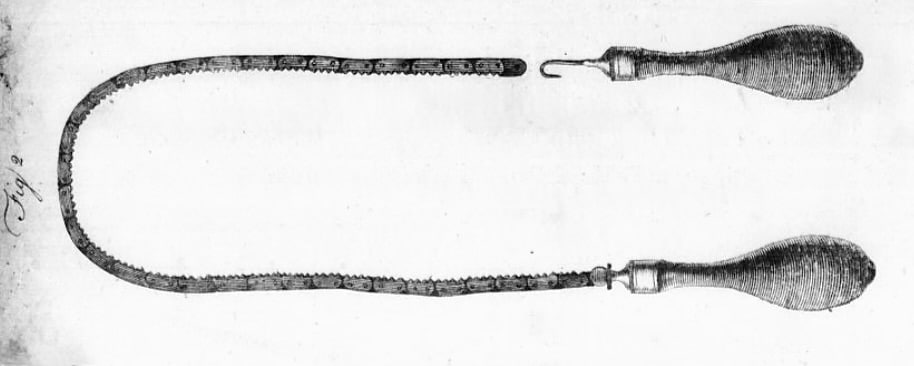
1893 – Gigli designed a thin (0.65mm) flexible, rough wire saw (Drahtsäger) which was operated by pulling on detachable handles at either end (Gigli saw)
Quando io ebbi i primi modelli di questa sega io sperai di poter con questi sostituire intieramente la sega a catena, strumento difficile a sterilizzarsi, costoso, che troppo facilmente si rompe e che non raggiunge certo l’ideale sottigliezza del filo metallico.
Applicato il filo-sega con pochi colpi si compie la sezione dell’osso con la più grande sicurezza e facilità, tagliando la superfice ossea così nettamente come se fosse non segata ma tagliata col coltello. Io sono riuscito più volte con questi fili a segare in brevissimo tempo completamente un bacino nel punto più alto.
When I had the first models of this saw I hoped that with these I could completely replace the chain saw, a tool that is difficult to sterilize, expensive, breaks too easily and certainly does not reach the ideal thinness of the metal wire.
With the wire saw applied we can accomplish division of the bone with a few strokes, easily and with great safety, as though the bone were not being sawed but cut with a knife. I have succeeded several times with these wires in sawing a pelvis completely at the highest point in a very short time.
1894 – Gigli expanded on work by Joseph-Alexis Stoltz (1803-1896) who realised that complications such as fatal bleeding from venous plexuses; bladder, vaginal and urethral lacerations could be overcome by avoiding cutting the symphysis pubis. Instead he proposed cutting on the pubic bone a few centimetres lateral to the midline (Gigli’s operation) with an instrument more delicate and accurate than the chain saw – the Gigli saw.
Die Drahtsäge wird in einer Stärke von 0,65 mm hergestellt und hat glatte, zu Schlaufen gebogene Enden…Um den Draht ohne besondere Instrumente in jeden beliebigen Teil des Skeletts einzuführen, wird eine stumpfe, biegsame Nadel mit einem Seidenfaden oder Silberdraht an der Schlaufe der Drahtsäge befestigt… Durch die Verwendung dieser Drähte wollte ich die Symphyseotomie vereinfachen und die Technik zuverlässiger machen. Ein schräger Schnitt durch das Schambein rechts oder links vom Kopfteil ist, wie Stolz bereits sagte, wesentlich einfacher und sicherer als der Medianschnitt, da er alle dessen Gefahren vermeidet und seine Vorteile bewahrt.
Applicato il filo-sega con pochi colpi si compie la sezione dell’osso con la più grande sicurezza e facilità, tagliando la superfice ossea così nettamente come se fosse non segata ma tagliata col coltello. Io sono riuscito più volte con questi fili a segare in brevissimo tempo completamente un bacino nel punto più alto.
By using the wire saw, I wanted to simplify the symphysotomy and make the technique more reliable. As Stoltz already mentioned, an oblique incision through the pubic bone to the right or left of the head is considerably easier and safer than the median incision, as it avoids all of the latter’s dangers and retains its advantages.
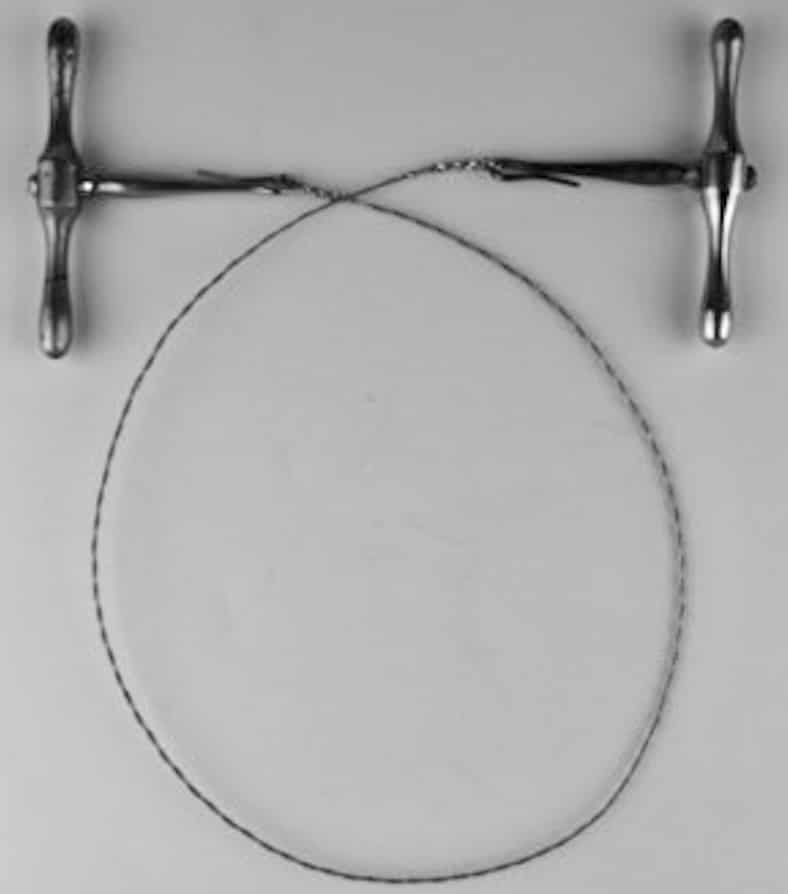
Lateralised Pubiotomy (Gigli’s operation) and Gigli saw position
Gigli proposed the Gigli saw for his novel procedure, the lateralized pubiotomy (Gigli’s operation) defining a new operation and the tool to perform it at the same time. The first lateralised pubiotomy was performed was performed successfully by Dr. B. Bonardi in Lugano, on May 7, 1897, whilst Gigli waited until 1902 to perform his first procedure on a live subject.
1897 – Gigli recommended this saw for all kinds of bone resection “with the exception, of course, of the skull.”
Seit den ersten Versuchen und Experimenten war mir klar, von welcher Wichtigkeit solch einfaches Instrument für die Chirurgie sein könne. Seine Feinheit, die Leichtigkeit, mit welcher es um jeden Knochen des Skeletts herumgeführt werden kann, die Möglichkeit, die Knochen in spitzen Winkeln und nach allen Richtungen zu sägen, die Exaktheit des Schnittes, die leichte und absolute Desinfektionsmöglichkeit, all dies macht die Säge zu einem idealen Instrument für die chirurgische Praxis.
Anfangs mit einer Art Misstrauen nur bei einfachen Operationen, wie Rippenresektion etc. angewendet, wurde es bald das bevorzugte Instrument bei vielen Knochenoperationen, abgesehen natürlich denjenigen an der Hirnschale.
From the first tests and experiments, it was clear to me how important such a simple instrument could be for surgery. Its delicacy, the ease with which it can be guided around every bone of the skeleton, the ability to saw bones at acute angles and in all directions, the precision of the cut, the ease and complete possibility of disinfection – all this makes the saw an ideal instrument for surgical practice.
Initially used with a certain degree of suspicion only for simple operations, such as rib resection, etc., it soon became the preferred instrument for many bone operations, with the exception, of course, those on the skull.
Introduction of the Wire Saw in Neurosurgery
1897 – Alfred Obaliński (1843-1898) of Jagiellonian University, Krakow advocated the use of the Gigli saw for cranial surgery. He noticed that it permitted the most cautious possible sawing-up of the skull bone
Zur Durchtrennung der Schädelknochen nach meiner Methode bedarf man zweier in der letzten Zeit hergestellten Instrumente, welche heute ein beschäftigter Chirurg nicht entbehren kann: des Perforarateurs mit der Krone nach Collin und der Drahtsäge nach Gigli.
Biegsame Drahtsäge nach Gigli durch, mit der man nun ohne jede Kraftanwendung und Erschütterung den Schädelknochen von innen nach außen durchsägt.
Weder mit dem Meißel noch mit der durch einen Mechanismus in Bewegung gesetzten Kreissäge ist man im Stande, so bequem und sicher den Schädelknochen an der Basis des Hautlappens ohne dessen Berührung zu durchsägen, wie eben durch diese von mir geübte Methode.
To transect the skull bones using my method, two recently manufactured instruments are required, which today no busy surgeon can do without: the Collin perforator with the crown and the Gigli wire saw.
A flexible Gigli wire saw is used to saw through the skull bone from the inside out without any force or vibration.
Neither a chisel nor a mechanically driven circular saw can saw through the skull bone at the base of the skin flap as easily and safely without touching it as with this method I practice.
1898 – Gigli responded with an historic paper on cranial resection. He devised a flexible whale bone guide (fig 1.) to introduce the saw under the bone without exerting pressure and the membranes of the brain.
Die größte Schwierigkeit der Technik der Kraniektomie mit meiner Säge besteht darin, letztere unter den Knochen des Schädels durchzuführen, und zwar ohne Ausübung von Druck und ohne Verletzung der Hirnhäute.
Ich habe zu dem Zweck eine Art rinnenförmiger Sonde ausführen lassen, die an ihrem Ende fast rechtwinklig gekrümmt ist.
…manchmal konnte ich das Fischbein auf der Oberfläche der Hirnhemisphären vom Hinterhauptsbein bis zum oberen Augenhöhlenrande vorgleiten lassen.
The greatest difficulty of the craniectomy technique with my saw is performing it beneath the bones of the skull without exerting pressure and without damaging the meninges.
For this purpose, I had a kind of groove-shaped probe made, curved at almost a right angle at its end.
…sometimes I was able to slide the whalebone along the surface of the cerebral hemispheres from the occipital bone to the upper orbital rim.
A silk thread was led under each edge of the flaps with another continuous thread following the same path with ends coming out of two adjacent burr holes (fig 2.). Pulling the latter thread led to a complete detachment of the dura from the inner table; pulling the former allowed the Gigli saw to pass under the edges of the flap (fig 3).
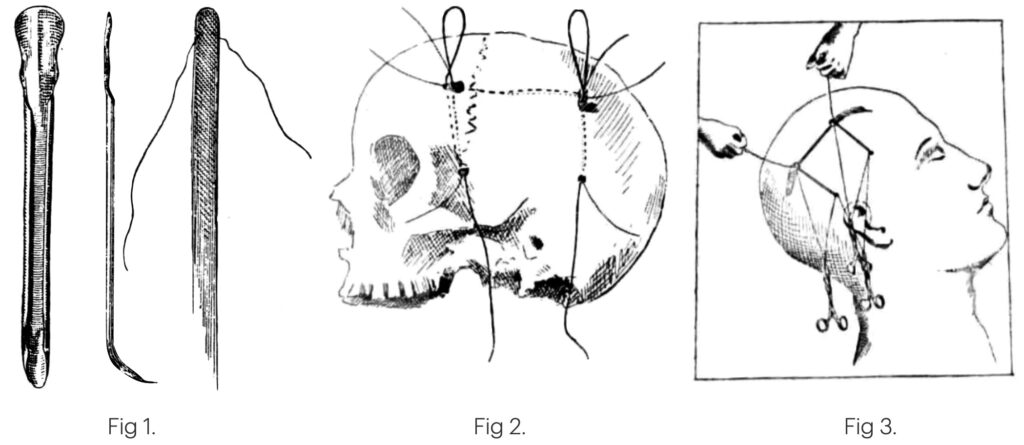
1900 – Gigli even went one stage further and devised a self-blocking trepan and modified the whalebone with flexible steel. He then created a device made from two steel straws parallel to each other and curved at one end. Threads were passed through the straw cavity into the narrow burr hole and the operation simplified.
Monopoly and POW escape
Major Christopher Clayton Hutton (Clutty) revealed in his 1961 publication ‘Official Secret’, how the Gigli saw was used to help prisoners of war (POWs) escape.
Board games were allowed into camps as the Germans believed they provided a diversion for POWs whose main activity was trying to figure out how they could escape. A game with a large board could hide a silk map, a small compass, a Gigli saw, and a file. Waddingtons manufactured silk maps and Monopoly which was large enough to conceal the inventory and include fake money to conceal the real money that POWs on the run would need. It was the perfect all-in-one escape kit.
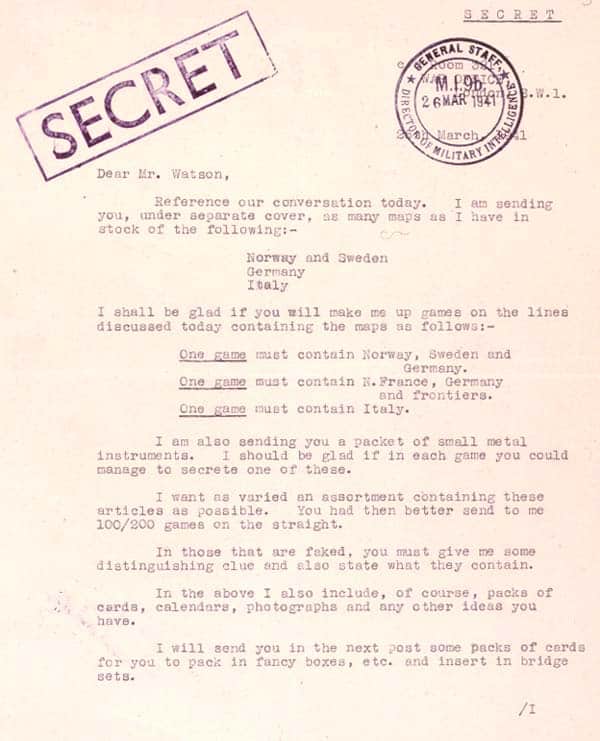
When the war ended in September 1945, Monopoly was the only escape kit the Germans hadn’t discovered. According to Philip E. Orbanes, a Monopoly historian at least 744 airmen escaped with aids created by Clutty. Among them was American officer, Lieutenant David Bowling, a prisoner at Stalag Luft III who managed to escape in late 1943, and travelled with German money, a silk map, a tiny compass, wire cutters, and a Gigli saw, which most likely came from a Monopoly game.
Major Publications
- Gigli L. Sopra una nuova modificazione delle applicazioni del forcipe Tarnier nello scavo. Annali di Ostericia e Ginecologia 1892; 14: 654-665.
- Gigli L. Della sezione della sinfisi con la sega in filo metallico (Drahtsäger). Annali di Ostericia e Ginecologia 1893; 15: 557–60. [Gigli saw]
- Gigli L. Über ein neues Instrument zum Durchtrennen der Knochen, die Drahtsäge. Zentralblatt für Chirurgie 1894; 21(18): 409–411 [Gigli saw]
- Gigli L. Taglio lateralizzato del pube. Suoi vantaggi. Sua tecnica. Annali di Ostericia e Ginecologia 14: 649–667, 1894 [Gigli operation]
- Gigli L. Zur praktischen Verwerthung der Drahtsäge. Zentralblatt für Chirurgie 1897; 24(29): 785–788
- Gigli L. Zur Technik der temporären Schädelresektion mit meiner Drahtsäge. Zentralblatt für Chirurgie. 1898; 25(16): 425–428 [Gigli saw and craniectomy]
- Gigli L. Über einige Modifikationen an dem Instrumentarium und der Technik der Kraniektomie mit meiner Drahtsäge. Zentralblatt für Chirurgie 1900; 27(48): 1193–1199
- Gigli L. Lateralschnitt durch das Os pubis. Zentralblatt für gynäkologie 1902; 29: 1298–1303
- Gigli L. Lateralschnitt des Beckens. Zentralblatt für gynäkologie 1904; 31: 281–290
References
Biography
- Bruno E. Leonardo Gigli (1863–1908). Archivio Italiano di Ginecologia. 1908; 1: 165–168
- Bossi LM. Nel trigesimo della morte di Leonardo Gigli. Fossati, Mediolan 1908.
- Resinelli G: Leonardo Gigli. La Ginecologia 1908; 5: 193–198
- Serafino P. Leonardo Gigli. La Ginecologia Moderna. Rivista Italiana di Ostetricia e Ginecologia 1908, 5: 225–230.
- Baskett TF. Gigli, Leonardo (1863–1908). In: Eponyms and Names in Obstetrics and Gynaecology. 3e. 2019: 153-154
Eponymous terms
- Aitken J. Principles of midwifery, or puerperal medicine. 1785
- Jefray J. Cases of the Excision of Carious Joints by H. Palt and P. F. Moreau with Observations by James Jeffray M. D. Glasgow: John Scrymgeour, 1806
- Obalinski A. Zur Technik der Schädeltrepanation. Zentralblatt für Chirurgie 1897; 24: 857-859
- Bonardi B. Taglio lateralizzato del pube col filo sega di Gigli in donna a termine con bacino piatto rachitico: esito felice per la madre e pel feto. Annali di Ostericia e Ginecologia. 1898; 20: 85–90
- Clayton Hutton. Official Secret : The Incredible story of Escape Aids Used During World War II Told Here for the First Time. 1961
- Ljunggren B. Leonardo Gigli and His Cranial Saw. In: Great men with sick brains. 1990: 9-10
- Brunori A, Bruni P, Greco R, Giuffré R, Chiappetta F. Celebrating the centennial (1894-1994): Leonardo Gigli and his wire saw. J Neurosurg. 1995 Jun;82(6):1086-90.
- Skippen M, Kirkup J, Maxton RM, McDonald SW. The chain saw – a Scottish invention. Scott Med J. 2004 May;49(2):72-5.
- Leonardo Gigli e la sua sega. Storia della Medicina.
- McCarthy E. How an Intelligence Officer Used Monopoly to Free POWs. Mental Floss. 2015
- Nica DA, Moisa HA, Mohan A, Ciurea AV. Leonardo Gigli and the Gigli Saw-Gigli Redivivus. World Neurosurg. 2020 Mar;135:35-37.
Eponym
the person behind the name
BA MA (Oxon) MBChB (Edin) FACEM FFSEM. Emergency physician, Sir Charles Gairdner Hospital. Passion for rugby; medical history; medical education; and asynchronous learning #FOAMed evangelist. Co-founder and CTO of Life in the Fast lane | On Call: Principles and Protocol 4e| Eponyms | Books |

